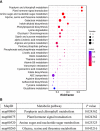Responses of differential metabolites and pathways to high temperature in cucumber anther
- PMID: 37123826
- PMCID: PMC10140443
- DOI: 10.3389/fpls.2023.1131735
Responses of differential metabolites and pathways to high temperature in cucumber anther
Abstract
Cucumber is one of the most important vegetable crops, which is widely planted all over the world. Cucumber always suffers from high-temperature stress in South China in summer. In this study, liquid chromatography-mass spectrometry (LC-MS) analysis was used to study the differential metabolites of cucumber anther between high-temperature (HT) stress and normal condition (CK). After HT, the pollen fertility was significantly reduced, and abnormal anther structures were observed by the paraffin section. In addition, the metabolomics analysis results showed that a total of 125 differential metabolites were identified after HT, consisting of 99 significantly upregulated and 26 significantly downregulated metabolites. Among these differential metabolites, a total of 26 related metabolic pathways were found, and four pathways showed significant differences, namely, porphyrin and chlorophyll metabolism; plant hormone signal transduction; amino sugar and nucleotide sugar metabolism; and glycine, serine, and threonine metabolism. In addition, pollen fertility was decreased by altering the metabolites of plant hormone signal transduction and amino acid and sugar metabolism pathway under HT. These results provide a comprehensive understanding of the metabolic changes in cucumber anther under HT.
Keywords: cucumber; high temperature stress; metabolomics; pollen fertility; starch and sucrose metabolism.
Copyright © 2023 Chen, Liang, Xie, Liu, Wang, Yan, Yang, Jiang, Peng and Lin.
Conflict of interest statement
The authors declare that the research was conducted in the absence of any commercial or financial relationships that could be construed as a potential conflict of interest.
Figures







Similar articles
-
Disruptions of sugar utilization and carbohydrate metabolism in rice developing anthers aggravated heat stress-induced pollen abortion.Plant Physiol Biochem. 2023 Sep;202:107991. doi: 10.1016/j.plaphy.2023.107991. Epub 2023 Aug 29. Plant Physiol Biochem. 2023. PMID: 37660606
-
Abnormal anther development leads to lower spikelet fertility in rice (Oryza sativa L.) under high temperature during the panicle initiation stage.BMC Plant Biol. 2021 Sep 20;21(1):428. doi: 10.1186/s12870-021-03209-w. BMC Plant Biol. 2021. PMID: 34544370 Free PMC article.
-
Phenotypic Characteristics and Transcriptome of Cucumber Male Flower Development Under Heat Stress.Front Plant Sci. 2021 Oct 22;12:758976. doi: 10.3389/fpls.2021.758976. eCollection 2021. Front Plant Sci. 2021. PMID: 34745192 Free PMC article.
-
Lipid Metabolism: Critical Roles in Male Fertility and Other Aspects of Reproductive Development in Plants.Mol Plant. 2020 Jul 6;13(7):955-983. doi: 10.1016/j.molp.2020.05.009. Epub 2020 May 17. Mol Plant. 2020. PMID: 32434071 Review.
-
Pollen development at high temperature and role of carbon and nitrogen metabolites.Plant Cell Environ. 2019 Oct;42(10):2759-2775. doi: 10.1111/pce.13576. Epub 2019 Jun 19. Plant Cell Environ. 2019. PMID: 31077385 Review.
Cited by
-
The genomes of Australian wild limes.Plant Mol Biol. 2024 Sep 24;114(5):102. doi: 10.1007/s11103-024-01502-4. Plant Mol Biol. 2024. PMID: 39316221 Free PMC article.
References
Grants and funding
LinkOut - more resources
Full Text Sources
Research Materials

